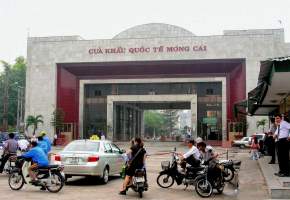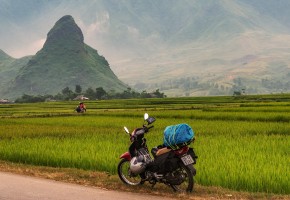
Trains, buses, taxis
Trains, buses & taxis form the backbone of the public transport system used by most Vietnamese — the good news is that with a little planning they can be excellent means of transport for international travelers too.
Trains
Vietnam’s first length of 71 km of train track was laid in 1881 and ran from Saigon to My Tho — a service which, unfortunately, no longer runs today.
The rail network expanded rapidly over the next 50 years and was essentially completed in 1936, much as it stands today.
It stretches for around 2,600 km in its entirety, of which the Ho Chi Minh to Hanoi line accounts for 1,700 km. The railway system is owned and operated by the government’s Vietnam Railways, but on the Hanoi to Lao Cai line servicing the hill town of Sapa, private operators have their own carriages and offer premium services.
Trains remain a great way to travel in Vietnam, if you have the time to go at a leisurely pace. It’s incredibly relaxing watching rice fields and towns and rural life go by as the train winds through the countryside, and the whole experience evokes a sense of earlier times.
It will be a deeper, more genuine Vietnamese experience than flying, but it will take a lot — multiple days — longer.
Vietnam’s air-conditioned trains are safe, comfortable and inexpensive. The rail network extends to most key destinations — only the mountainous provinces north & north east of Hanoi, the Central Highlands and the Mekong Delta are not covered.
Officially the Vietnamese train system consists of seven rail lines, but of those only three are commonly used by foreign travelers: Ho Chi Minh to Hanoi, Hanoi to Lao Cai and Hanoi to Dong Dang on the border with China.
Researching timetables and making bookings online is easy provided you keep away from the many dodgy websites in this area.
The official English language website for Vietnam Railways has some useful information and pictures of trains and cabins, plus up to date timetables (if a page appears blank, switch to Vietnamese — not all pages exist in English).
We also like Seat61 for its overview of train travel in Vietnam, timetables and descriptions of cabins, instructions on how to buy tickets online as well as how to collect them at the station, and sheer enthusiasm for traveling by train.
Ho Chi Minh to Hanoi
The main north-south line is by far the most popular for both foreign tourists and Vietnamese travelers.
Since it was originally constructed, it has been bombed, left to fall into disrepair, and then rebuilt and reopened in 1976 after the Vietnam war (called the American war by the Vietnamese) to mark the country’s re-emergence.
Often referred to as the “Reunification Express”, the line has over 100 stations including Hanoi, Vinh, Dong Hoi (good for visiting the caves at Phong Ngha), Dong Ha, Hue, Da Nang (for visiting the historic port town of Hoi An), Quang Ngai, Dieu Tri (for the beaches of Quy Nhon), Nha Trang (for beaches and resorts), Thap Cham, Muong Man (for the sand dunes and kite surfing of Mui Ne) and Saigon.
The full trip between Ho Chi Minh and Hanoi takes around 35 hours, give or take, though many travelers break the journey into sections.
There are many articles on the internet on the Reunification Express — it is worth reading a few of them to get a detailed picture of the what the journey is like, including the different types of cabins available, food services etc.
Hanoi to Lao Cai
Heading northwest from Hanoi, this line terminates at the border town of Lao Cai. From here it is a straightforward bus or taxi ride up to the hill station of Sapa — one of northern Vietnam’s most popular (and unfortunately most congested) tourist spots.
Seat61 has a good, detailed section on Hanoi to Lao Cai including information on the privately run premium-service carriages, which is what most travelers will want to book, and which run at night.
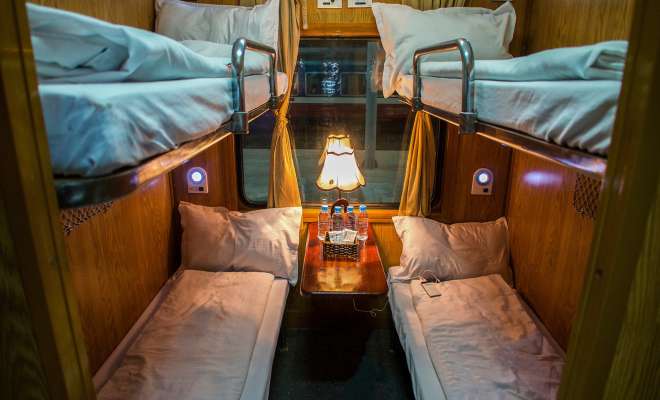
Some of the more expensive services such as Fanxipan Express or the Victoria have luxury cabins in an old-world style and traveling overnight is quite an experience, even if the train stops just as often and just as noisily as for the less expensive cabins (our suggestion: bring ear plugs and eye masks).
The day trains are mostly wooden-seated non-air-con carriages. In our experience, for day travel to Lao Cai and Sapa it is better to forsake the possibly entertaining day train experience to take one of the express buses — more comfortable and much faster.
Hanoi to Dong Dang
Dong Dang is the border town, in Lang Son province, on the Chinese frontier, and this train, running northeast of Hanoi, is the most popular way to reach it.
Train classification
There are four main classes of Vietnamese trains / cabins — hard seat, soft seat, hard sleeper and soft sleeper, with a number of sub-classes (note that this classification does not include the more luxe private cabins available on the Hanoi – Lao Cai line).
Hard seats are aptly named. They are wooden bench seats, devoid of comfort, and the cheapest class on the train. They are the first to fill up and invariably packed. Best to avoid, we figure.
Soft seats are considerably more comfortable and are more than adequate for day-travel, however they are far from comfortable for sleeping. There are three types — reclining (in principle) air-con, air-con, and non air-con. Get the reclining air-con.
Hard sleepers are not as bad as they sound, offering a rather thin mattress for you to sleep on. More than adequate for the budget traveler, cabins have a six-berth configuration with both a fan-cooled and air-con option (go for the air-con).
The bunk prices range from the cheapest bunk on top, then the middle one, with the lowest bunk being the most expensive. The compartments are door-less, so you need to be extra careful with your belongings.
Soft sleepers — by far our first choice, they are the most comfortable class and come with surprisingly soft beds in a four-bed configuration, with or without air-con.
We recommend the air-con, but be aware that these compartments can be ridiculously cold, especially if you are in the top bunk, so pack a sweater and long pants.
Unlike hard sleepers, these compartments do have a door so are considerably more secure. There is no difference in the price of the bunks. Some people like the lower bunks; some the upper. We go for the lower, for convenience and not as close to the air-con.
Buses
Grabbing a bus is an economical and interesting way to get around, both within cities and towns, as well as traveling between them. It’s a viable alternative for those who don’t want to ride a motorbike or rent a car & driver.
Vietnam’s longer haul inter-city bus system has come a long way in the past few years, and as chaotic as it sometimes seems, it is now fairly easy to book your own bus, with ticket offices displaying official prices and clear departure times.
Be aware that cities often have more than one bus station or terminus, with each servicing different destinations, based mostly on the direction of the destination city (north, south, east, west), as well as the type of service, long distance vs local, express vs milk run (we suggest express, of course). It can be confusing selecting the correct bus station — do your homework and know where on the map it is.
The main problem you are likely to have in purchasing tickets is that ticket office staff might not speak English. So be ready to do a lot of gesturing and picture drawing, and bring along your good friends Google translator and Google maps.
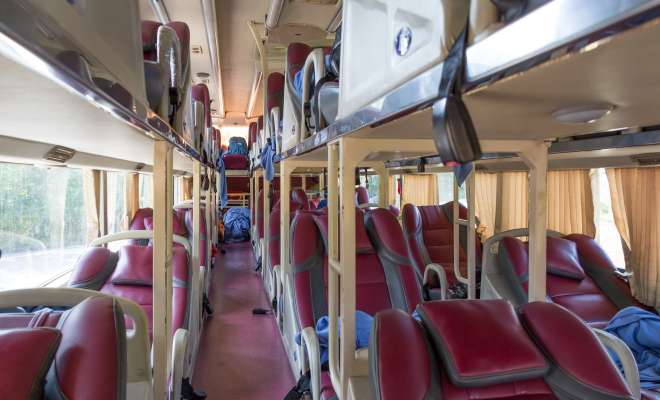
Sleeper buses, running overnight journeys and operated by a variety of companies, are modern, economical, clean and (relatively) comfortable. They are a good way to travel long kilometers between major centres.
The seats recline to an almost horizontal position, allowing you a few hours of sleep on those overnight rides. The seats when fully reclined might be a tad short for a tall westerner, but overall are not too bad. We have traveled many kilometers this way ourselves.
When you have your ticket booked and in hand, you can be assured of your own seat. However, the buses typically make several roadside stops along the way to pick up extra passengers, who will then sprawl out on the floor below you, sleeping where they can. It makes for a very genuine Vietnamese experience.
The temperature in these buses can be fairly cool, so apart from the blankets provided, we recommend bringing a light weight top. Also, we suggest you invest in ear plugs and eye masks.
A relatively new class of “limousine bus” has been introduced in recent years, typically 16-20-passenger buses, fewer than in the older style buses. They are spacious and comfortable, with reclining seats. They claim to offer better service as well as guarantee that no extra passengers will get squeezed in — however this is not always the case! Overnight versions have sleeper style seats, but with fewer seats and more space.
The prices are slightly higher than the older style buses, and the departure and arrival times are not as varied — but overall we recommend the limousine buses as the most comfortable choice for inter city trips.
There are also “open-tour” buses — long-distance hop-on, hop-off buses, often mini-buses, which go to most regional cities in Vietnam. They service locals, can be packed to the gills with people, luggage and sometimes animals, and are also occasionally used by hardier budget travelers. The mini-buses can be fun in spring and autumn, but pretty challenging in the heat of summer.
The larger hop-on hop-off buses offer both sleeper and sitting buses, and the price is generally very reasonable; however, the level of service has been said to vary among different providers, so do your research before you book.
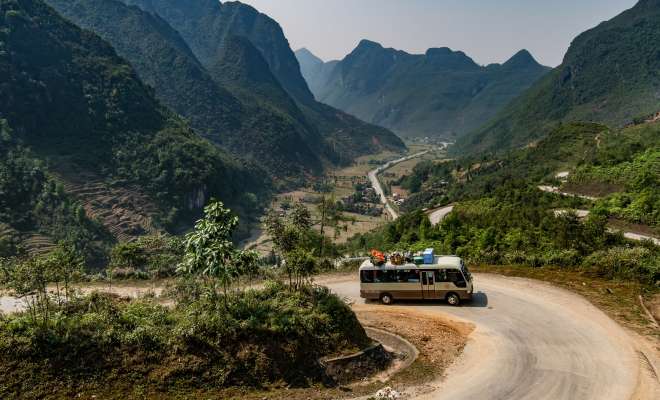
Local intra-city transport
While Vietnam is a fairly safe country in which to travel, we suggest you be cautious while using local public transport, especially within major cities, and keep your belongings close to you. An ounce of prevention is worth a pound of cure.
Local city buses
City buses are not very popular with either travelers or local expats for a variety of reasons — they are mostly old, crowded, not very comfortable, hot and drivers rarely speak any English.
In addition, the price of other means of city transportation including taxis, cyclos, electric cars and xe oms, is so affordable that people tend to choose these over buses.
That being said, the bus systems in the major cities are relatively easy to negotiate, bus maps are easily available online, and newer, cleaner models of city buses are gradually making buses a better transportation alternative.
Metered taxis, and Grab – the Uber of Vietnam
Metered taxis are widely available in most major cities, and very affordable by international standards.
Together with Grab (which is the Uber for Vietnam, operating in major cities), they are the safest way to travel locally, especially at night.
The more reputable taxi companies (Mai Linh, ABC, G7, Hanoi Taxi Group, Hanoitourist, and HCM’s Vinasun) are fair, reasonably priced, and their meters are standardized.
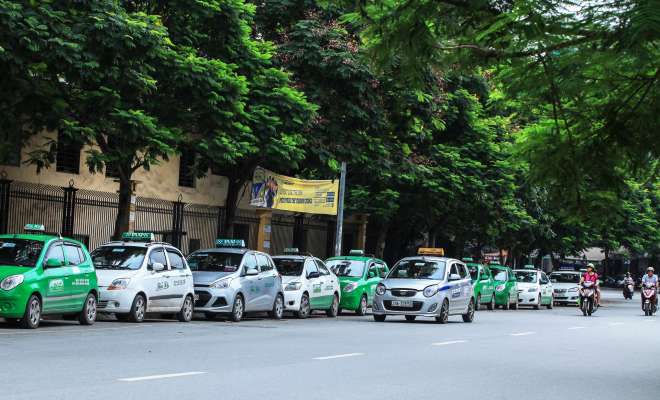
However, beware – there are plenty of dodgy taxis that often hang around bus and train terminals and late-night bars whose meters run verrrry fast. It is advisable to wave these taxis off, and walk a short distance away from bus and train terminals to get one of the safe, recommended taxis. Click here for more information on taxi (and other) scams.
In recent years, Grab has been increasingly successful on the local taxi and xe om (motorbike taxi) scene, offering even lower prices and fantastic service.
You can download the Grab app onto your smart phone — it works very much like Uber, and has enough English to be usable even if you speak no Vietnamese (you can use Google Translate to make sense of the Vietnamese bits). You can pay in cash, which makes it usable by tourists. Your hotel can help you to get a Grab taxi if you do not have the app on your smartphone.
Xe-oms
Xe-oms (pronounced ‘say-ohm’) are motorbike taxis, and as long as you are traveling fairly light, they are an easy and interesting way to get around.
There are xe-oms waiting on every corner, sometimes advertising their services with a hand-written cardboard sign, other times just patiently waiting for customers to walk by.

The price of the service should always be negotiated before you get on the bike, and you should ensure that a helmet is provided (it’s required by law).
Recently, a handful of regulated xe-om companies have been offering motorbike taxi services with clearly stated rates, avoiding the need to negotiate the price. As mentioned, Grab is also now widely available, convenient, safe, and hassle-free.
Two new xe-om companies, Go Viet and Be, are giving Grab some healthy competition, but we have not yet tried either of these services.
Bicycles
Bicycles used to be the main form of local transportation throughout most of the cities and towns in Vietnam, but gave way to motorbikes and cars as the most efficient way to get around.
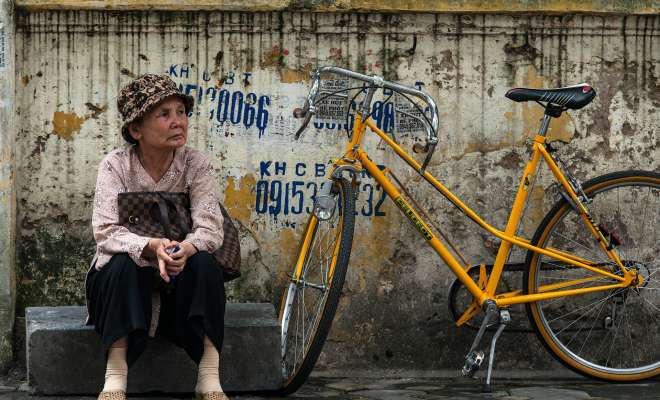
However, in the past few years, as the economy has grown steadily stronger, and people have had more disposable income, bicycle shops have become a burgeoning business, and the pastime of cycling has become quite fashionable.
Riding a bicycle can be a fabulous way to explore the major cities and their near environs. Cars, buses and trucks are accustomed to the presence of bicycles, and generally give sufficient leeway for the bicycle’s safe passage. However, this is Vietnam and traffic and drivers can be somewhat crazy — so you need to be careful and ride defensively.
Always wear a proper cycling helmet, stay close to the curb, use hand signals, keep your eyes on the road and be prepared to give way. At night, it’s best not to ride, but if you must, having a headlamp as well as both a front light and flashing back light are a must.
Regardless of the congested streets, Vietnam’s cities and towns all have their little hidden gems, lesser-used roads and paths, waiting to be discovered by bicycle. With an experienced, knowledgeable guide, it makes for a great day or half day tour — see our Hanoi Insider’s Bicycle Tours.
Cyclos
Cyclos, otherwise known as bicycle rickshaws, are a classic French colonial era means of transportation that have, sadly, all but disappeared in the last few years.
If you want to hire a cyclo on your own, it is imperative that you negotiate the fare before you climb aboard, and in order to ensure that your destination is understood by the driver, it would be useful to bring along a city map.
As cyclos are still a popular tourist attraction, there is still a handful of companies that operate them, and your hotel could likely help you to book one, or at least tell you how much the fare should be.
However, because they are considered to be somewhat of a traffic hazard, they are gradually being phased out and replaced by the more modern (but far less charming) electric touring cars.

Electric cars for site-seeing
Electric cars, a relatively new, eco-friendly means of transportation in Vietnam, are quickly becoming the preferred sight-seeing option in Vietnam’s major cities.
The cars, using solar batteries rather than fuel, are equipped with an audio system, informing visitors about the area’s history, architecture, and other interesting facts, on an average 45-minute tour.
Your hotel can help you book. The cars can also be privately rented for an unlimited amount of time.
Personally, we’d go by bicycle or motorbike, or even cyclo.
Car & driver
Despite a somewhat recent new Vietnamese traffic law (from 2015) that recognizes international drivers’ licenses, from a practical point of view no car-rental agency will allow you to self-drive — all car rentals come with a driver.
Given the relatively hazardous nature of driving in Vietnam, and how different the actual on-the-ground rules of the road are from Western countries (forget the written rules), this is probably a good thing.
It’s hard to find a driver who both speaks English and who knows the best places to go let alone one who has a guide certification — most drivers know just the major roads to the major sites. If you want to get off the beaten path a bit or understand what you are visiting or explore the gems away from the crowds, you will need to hire a good guide as well as a car plus driver.
Best done via a tour company who really knows North Vietnam and has good guides — we think that’s us, Other Path Travel!
Done right, a private car & driver & guide is one of the very best ways of traveling through and discovering Vietnam.
Motorbikes
And saving the best for last — riding a motorbike, whether in urban or rural settings, is one of the best ways to experience Vietnam.
The connection with the landscapes and people is amazing, especially if you ride a relatively small bike, coming closer to how the locals experience their country (in any case, the back roads are so winding that a large bike is impractical).
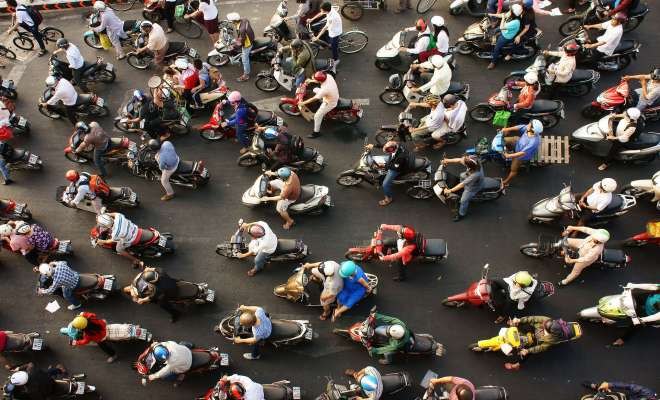
Riding a motorbike in the city can be exhilarating and exciting. The key, however, to a safe, enjoyable, thrilling motorbike experience is to be a competent rider. We know the traffic seems crazy, especially inner-city, and it is, mostly, but if you have previous riding experience (and certification), once you get the hang of it, you’ll learn there is a method to the madness. When in Rome … do as the Romans. And when in Vietnam … ride a motorbike!



